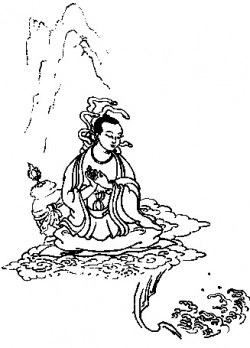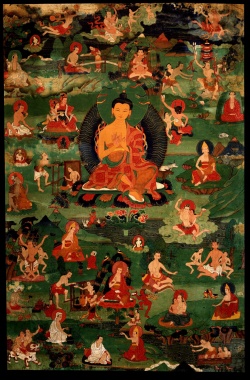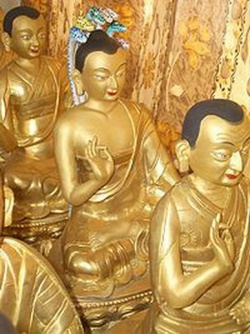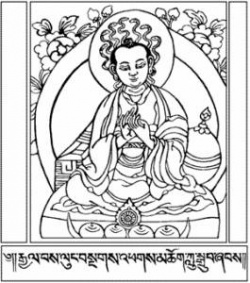Difference between revisions of "Mūlamadhyamakakārikā"
| (21 intermediate revisions by 4 users not shown) | |||
| Line 1: | Line 1: | ||
| − | The | + | The [[Mūlamadhyamakakārikā]] <ref>Also known as the ''[[Prajñā-nāma-mūlamadhyamakakārikā]]'' or as the ''[[Mūlamadhyamakakārikā-prajñā-nāma]]''.</ref> ({{Wiki|Devanagari}}: [[मूलमध्यमककारिक]]), or [[Fundamental Verses on the Middle Way]]''''', is a key text of the [[Madhyamaka|Madhyamaka-school]], written by [[Nagarjuna]], one of the most important [[Buddhist]] {{Wiki|philosophers}}. |
[[File:Nagarjuna1.jpg|thumb|250px|]] | [[File:Nagarjuna1.jpg|thumb|250px|]] | ||
| + | |||
| + | |||
==Origin== | ==Origin== | ||
| − | The Mūlamadhyamakakārikā is Nagarjuna's best known work. It is | + | |
| − | :Not only a grand commentary on the Buddha's discourse to Kaccayana,<ref>See [http://www.accesstoinsight.org/tipitaka/sn/sn12/sn12.015.than.html SN 12.15 Kaccayanagotta Sutta: To Kaccayana Gotta (on Right View) | + | |
| + | The [[Mūlamadhyamakakārikā]] is [[Nagarjuna]]'s best known work. | ||
| + | |||
| + | It is :Not only a grand commentary on the [[Buddha]]'s {{Wiki|discourse}} to [[Kaccayana]],<ref>See [http://www.accesstoinsight.org/tipitaka/sn/sn12/sn12.015.than.html SN 12.15 [[Kaccayanagotta Sutta]]: | ||
| + | |||
| + | To [[Kaccayana Gotta]] (on [[Right View]]) </ref> the only {{Wiki|discourse}} cited by [[name]], but also a detailed and careful analysis of most of the important [[discourses]] included in the [[Nikayas]] and the [[agamas]], especially those of the ''[[Atthakavagga]]'' of the ''[[Sutta-nipata]]''. | ||
In this work, | In this work, | ||
| − | :Utilizing the Buddha's theory of [[Pratītyasamutpāda | + | :Utilizing the [[Buddha]]'s {{Wiki|theory}} of [[Pratītyasamutpāda]]"[[dependent arising]]"([[pratitya-samutpada]]), [[Nagarjuna]] demonstrated the futility of [...] {{Wiki|metaphysical}} speculations. His method of dealing with such {{Wiki|metaphysics}} is referred to as "[[middle way]]" (''[[madhyama pratipad]]''). |
| + | |||
| + | It is the [[middle way]] that avoided the {{Wiki|substantialism}} of the [[Sarvastivada|Sarvastivadins]] as well as the {{Wiki|nominalism}} of the [[Sautrāntika|Sautrantikas]]. | ||
| + | [[File:Amit.jpeg|thumb|250px|]] | ||
| + | [[Nagarjuna]] insisted that... | ||
| + | :All [[experienced]] [[phenomena]] are [[sunyata|empty (''[[sunya]]'')]]. | ||
| + | |||
| + | This did not mean that they are not [[experienced]] and, therefore, {{Wiki|non-existent}}; | ||
| + | |||
| + | only that they are devoid of [[Svabhava|a permanent and {{Wiki|eternal}} substance (''[[svabhava]]'')]]. Since they are [[experienced]], they are not [[Prajnaptivada|mere names (''[[prajnapti]]'')]]. | ||
| + | |||
| − | + | =={{Wiki|Exegesis}} and {{Wiki|commentarial}} {{Wiki|literature}}== | |
| − | |||
| − | |||
| − | |||
| − | The earliest known commentary by another author is now preserved within the first Chinese translation of the Kārikā, known as the "Middle Treatise" (中論 Zhong Lun), translated by [[Kumārajīva | + | The ''[[Akutobhayā]]'', whose authorship is unknown, though is attributed to [[Nagarjuna]] in the [[tradition]], is held by Ames to be the first commentary on the MMK.<ref name="Ames, William L. 1993 p.209">Ames, William L. (1993). "[[Bhāvaviveka's]] ''[[Prajñāpradīpa]]'' ~ A Translation of [[Chapter]] One: '[[Examinations of Causal Conditions]]' (''[[Pratyaya]]'')". ''[[Journal of Indian Philosophy]]'', 1993, vol.21. {{Wiki|Netherlands}}: Kluwer {{Wiki|Academic}} Publishers, p.209</ref> |
| + | |||
| + | The earliest known commentary by another author is now preserved within the first {{Wiki|Chinese}} translation of the [[Kārikā]], known as the "[[Middle Treatise]]" ([[中論]] [[Zhong Lun]]), translated by [[Kumārajīva]] in 409. | ||
| + | |||
| + | The author of this commentary is given as either "[[Blue Eyes]]" ([[青目]]; back translated as *[[Vimalākṣa]]) or *[[Piṅgala]] ([[賓伽羅]]). | ||
| + | |||
| + | This is by far the best known commentary in [[East Asian Mādhyamaka]], forming one of the three commentaries that make up the [[Sānlùn|San Lun]] School. | ||
| + | |||
| + | |||
| + | The best-known commentary in later [[Indian]] and [[Tibetan Buddhism]] is [[Candrakīrti|Candrakirti's]] ''[[Prasannapadā]]'' ([[Clear Words]]), which survives in [[Sanskrit]] {{Wiki|and}} [[Tibetan]] translation. | ||
| + | |||
| + | |||
| + | [[File:Buddhist bells.jpg|thumb|250px|]] | ||
| + | ==[[Form]] and content of the text== | ||
| − | |||
| − | |||
===The early chapters=== | ===The early chapters=== | ||
| + | |||
| + | |||
[[File:Nagarjuna2.jpg|thumb|250px|]] | [[File:Nagarjuna2.jpg|thumb|250px|]] | ||
| − | # {{IAST|Pratyayaparīkṣā}}: Analysis of conditions | + | # {{IAST|[[Pratyayaparīkṣā]]}}: [[Analysis of conditions]] |
| − | # {{IAST|Gatāgataparīkṣā}}: Analysis of going and not going | + | # {{IAST|[[Gatāgataparīkṣā]]}}: [[Analysis of going and not going]] |
| − | # {{IAST|Cakṣurādīndriyaparīkṣā}}: Analysis of the eye and the other sense-organs | + | # {{IAST|[[Cakṣurādīndriyaparīkṣā]]}}: [[Analysis of the eye and the other sense-organs]] |
| − | # {{IAST|Skandhaparīkṣā}}: Analysis of the [[skandha]]s ((mental) "aggregates") | + | # {{IAST|[[Skandhaparīkṣā]]}}: Analysis of the [[skandha]]s (([[mental]]) "[[aggregates]]") |
| − | # {{IAST|Dhātuparīkṣā}}: Analysis of the [[dhatu|dhatūs]] ("constituents" or "strata" (in the sense of metaphysical substrata)) | + | # {{IAST|[[Dhātuparīkṣā]]}}: Analysis of the [[dhatu|dhatūs]] ("constituents" or "strata" (in the [[sense]] of {{Wiki|metaphysical}} {{Wiki|substrata}})) |
| − | # {{IAST|Rāgaraktaparīkṣā}}: Analysis of passion and the impassioned | + | # {{IAST|[[Rāgaraktaparīkṣā]]}}: Analysis of [[passion]] and the impassioned |
| − | # {{IAST|Saṃskṛtaparīkṣā}}: Analysis of the conditioned | + | # {{IAST|[[Saṃskṛtaparīkṣā]]}}: Analysis of the [[conditioned]] |
| − | # {{IAST|Karmakārakaparīkṣā}}: Analysis of action and actor | + | # {{IAST|[[Karmakārakaparīkṣā]]}}: Analysis of [[action]] and actor |
| − | # {{IAST|Pūrvaparīkṣā}}: Analysis of the past | + | # {{IAST|[[Pūrvaparīkṣā]]}}: Analysis of the {{Wiki|past}} |
| − | # {{IAST|Agnīndhanaparīkṣā}}: Analysis of fire and fuel | + | # {{IAST|[[Agnīndhanaparīkṣā]]}}: Analysis of [[fire]] and fuel |
| − | # {{IAST|Pūrvaparakoṭiparīkṣā}}: Analysis of past and future limits | + | # {{IAST|[[Pūrvaparakoṭiparīkṣā]]}}: Analysis of {{Wiki|past}} and {{Wiki|future}} limits |
| − | # {{IAST|Duḥkhaparīkṣā}}: Analysis of suffering | + | # {{IAST|[[Duḥkhaparīkṣā]]}}: Analysis of [[suffering]] |
| + | |||
===The later chapters=== | ===The later chapters=== | ||
| + | |||
*The [[Śūnyatā|emptiness]] of all things (i.e., all things, including the [[Gautama Buddha|Buddha]]) ([[Mūlamadhyamakakārikā#22:26]]) | *The [[Śūnyatā|emptiness]] of all things (i.e., all things, including the [[Gautama Buddha|Buddha]]) ([[Mūlamadhyamakakārikā#22:26]]) | ||
| − | *The identity of [[Pratitya-samutpada|pratītyasamutpāda]] with [[shunyata|śunyatā]] ([[Mūlamadhyamakakārikā#24:18]]) | + | |
| + | *The [[Wikipedia:Identity (social science)|identity]] of [[Pratitya-samutpada|pratītyasamutpāda]] with [[shunyata|śunyatā]] ([[Mūlamadhyamakakārikā#24:18]]) | ||
| + | |||
*The indifferentiability of [[nirvana|{{IAST|nirvāṇa}}]] from [[samsara|{{IAST|saṃsāra}}]] ([[Mūlamadhyamakakārikā#16:10]])([[Mūlamadhyamakakārikā#25:19-20]]) | *The indifferentiability of [[nirvana|{{IAST|nirvāṇa}}]] from [[samsara|{{IAST|saṃsāra}}]] ([[Mūlamadhyamakakārikā#16:10]])([[Mūlamadhyamakakārikā#25:19-20]]) | ||
| − | |||
| − | These chapters are as follows; note the clustering of 24-26, and also the nature of the last chapter: | + | *The tentative or merely [[Wikipedia:Convention (norm)|conventional]] [[nature]] of all [[truth]] ([[Mūlamadhyamakakārikā#22:11]]). |
| + | |||
| + | [[File:193453.jpg|thumb|250px|]] | ||
| + | These chapters are as follows; note the clustering of 24-26, and also the [[nature]] of the last [[chapter]]: | ||
| + | |||
| + | |||
[[File:Nagarjuna.jpg|thumb|250px|]] | [[File:Nagarjuna.jpg|thumb|250px|]] | ||
| − | * 13. {{IAST|Saṃskāraparīkṣā}}: Analysis of disposition | + | * 13. {{IAST|[[Saṃskāraparīkṣā]]}}: Analysis of disposition |
| − | * 14. {{IAST|Saṃsargaparīkṣā}}: Analysis of admixture | + | * 14. {{IAST|[[Saṃsargaparīkṣā]]}}: Analysis of admixture |
| − | * 15. {{IAST|Svabhāvaparīkṣā}}: Analysis of being or essence | + | * 15. {{IAST|[[Svabhāvaparīkṣā]]}}: Analysis of [[being]] or [[essence]] |
| − | * 16. {{IAST|Bandhanamokṣaparīkṣā}}: Analysis of bondage and liberation | + | * 16. {{IAST|[[Bandhanamokṣaparīkṣā]]}}: Analysis of bondage and [[liberation]] |
| − | * 17. {{IAST|Karmaphalaparīkṣa}}: Analysis of action and its fruit | + | * 17. {{IAST|[[Karmaphalaparīkṣa]]}}: Analysis of [[action]] and its [[fruit]] |
| − | * 18. {{IAST|Ātmaparīkṣā}}: Analysis of the [[anatta|soul]]. | + | * 18. {{IAST|[[Ātmaparīkṣā]]}}: Analysis of the [[anatta|soul]]. |
| − | * 19. {{IAST|Kālaparīkṣā}}: Analysis of time | + | * 19. {{IAST|[[Kālaparīkṣā]]}}: Analysis of [[time]] |
| − | * 20. {{IAST|Sāmagrīparīkṣā}}: Analysis of holism | + | * 20. {{IAST|[[Sāmagrīparīkṣā]]}}: Analysis of holism |
| − | * 21. {{IAST|Saṃbhavavibhavaparīkṣā}}: Analysis of becoming and un-becoming | + | * 21. {{IAST|[[Saṃbhavavibhavaparīkṣā]]}}: Analysis of becoming and un-becoming |
| − | * 22. {{IAST|Tathāgataparīkṣā}}: Analysis of the [[Tathagata|Tathāgata]] | + | * 22. {{IAST|[[Tathāgataparīkṣā]]}}: Analysis of the [[Tathagata|Tathāgata]] |
| − | * 23. {{IAST|Viparyāsaparīkṣā}}: Analysis of Error | + | * 23. {{IAST|[[Viparyāsaparīkṣā]]}}: Analysis of Error |
| + | |||
| + | |||
| + | * 24. {{IAST|[[Āryasatyaparīkṣā]]}}: Analysis of the [[Noble Truths]] | ||
| + | * 25. {{IAST|[[Nirvānaparīkṣā]]}}: Analysis of {{IAST|nirvāṇa}} | ||
| + | * 26. {{IAST|[[Dvādaśāṅgaparīkṣā]]}}: Analysis of the twelvefold chain (of [[dependent origination]]) | ||
| + | * 27. {{IAST|[[Dṛṣṭiparīkṣā]]}}: Analysis of [[View|views]] | ||
| + | [[File:1694916.jpg|thumb|250px|]] | ||
| − | |||
| − | |||
| − | |||
| − | |||
==Translations== | ==Translations== | ||
| + | |||
| + | |||
{| border="1" cellspacing="0" cellpadding="3" | {| border="1" cellspacing="0" cellpadding="3" | ||
|- | |- | ||
| Line 72: | Line 112: | ||
|- | |- | ||
| [[Gudo Wafu Nishijima]] and [[Brad Warner]] | | [[Gudo Wafu Nishijima]] and [[Brad Warner]] | ||
| − | | ''Fundamental Wisdom of the Middle Way: Nagarjuna's Mulamadhyamakakarika'' | + | | ''Fundamental [[Wisdom]] of the [[Middle Way]]: [[Nagarjuna]]'s [[Mulamadhyamakakarika]]'' |
| − | | Monkfish Book Publishing | + | | Monkfish [[Book]] Publishing |
| 2011 | | 2011 | ||
| ISBN 978-0-9833589-0-9 | | ISBN 978-0-9833589-0-9 | ||
| − | | A modern interpretation from a Zen perspective. | + | | A {{Wiki|modern}} [[interpretation]] from a [[Zen]] {{Wiki|perspective}}. |
|- | |- | ||
| − | | Mabja Jangchub Tsöndrü | + | | [[Mabja Jangchub Tsöndrü]] |
| − | | ''Ornament of Reason: The Great Commentary to Nagarjuna's Root of the Middle Way'' | + | | ''[[Ornament of Reason]]: The [[Great Commentary to [[Nagarjuna's Root of the Middle Way]]'' |
| − | | Snow Lion | + | | Snow [[Lion]] |
| 2011 | | 2011 | ||
| ISBN 978-1-55939-368-3 | | ISBN 978-1-55939-368-3 | ||
| − | | Commentary translated by The Dharmachakra Translation Committee. | + | | Commentary translated by The [[Dharmachakra]] Translation Committee. |
|- | |- | ||
| Jones, Richard H. | | Jones, Richard H. | ||
| − | | ''Nagarjuna: Buddhism's Most Important Philosopher'' | + | | ''[[Nagarjuna]]: [[Buddhism]]'s Most Important {{Wiki|Philosopher}}'' |
| Booksurge | | Booksurge | ||
| 2010 | | 2010 | ||
| ISBN 978-1-4515-3979-0 | | ISBN 978-1-4515-3979-0 | ||
| − | | Translation into idiomatic English with commentary and translations of other works by Nagarjuna. | + | | Translation into idiomatic English with commentary and translations of other works by [[Nagarjuna]]. |
|- | |- | ||
| [[Padmakara Translation Group]] | | [[Padmakara Translation Group]] | ||
| − | | ''The Root Stanzas on the Middle Way'' | + | | ''The [[Root]] [[Stanzas]] on the [[Middle Way]]'' |
| − | | Éditions Padmakara | + | | Éditions [[Padmakara]] |
| 2008 | | 2008 | ||
| ISBN 978-2-916915-44-9 | | ISBN 978-2-916915-44-9 | ||
| − | | A translation from the Tibetan, following (but not including) the commentary of the [[Nyingma]] and [[Rime movement|Rimé]] master [[Mipham Rinpoche|Jamgön Mipham Rinpoche]]. This volume, containing both the Tibetan text and translation, was made to mark the visit of His Holiness the Dalai Lama to France in August 2008, and as a support for the teachings scheduled for that occasion. | + | | A translation from the {{Wiki|Tibetan}}, following (but not including) the commentary of the [[Nyingma]] and [[Rime movement|Rimé]] [[master]] [[Mipham Rinpoche|Jamgön Mipham Rinpoche]]. This volume, containing both the {{Wiki|Tibetan}} text and translation, was made to mark the visit of [[His Holiness]] the [[Dalai Lama]] to {{Wiki|France}} in August 2008, and as a support for the teachings scheduled for that [[occasion]]. |
|- | |- | ||
| Luetchford, Michael J. | | Luetchford, Michael J. | ||
| − | | ''Between Heaven and Earth - From Nagarjuna to Dogen'' | + | | ''Between [[Heaven]] and [[Earth]] - From [[Nagarjuna]] to [[Dogen]]'' |
| Windbell Publications | | Windbell Publications | ||
| 2002 | | 2002 | ||
| ISBN 978-0-9523002-5-0 | | ISBN 978-0-9523002-5-0 | ||
| − | | A translation and interpretation with references to the philosophy of Zen Master [[Dogen]]. | + | | A translation and [[interpretation]] with references to the [[philosophy]] of [[Zen]] [[Master]] [[Dogen]]. |
|- | |- | ||
| [[Stephen Batchelor|Batchelor, Stephen]] | | [[Stephen Batchelor|Batchelor, Stephen]] | ||
| − | | ''Verses from the Center'' | + | | ''Verses from the [[Center]]'' |
| Diane Publishing | | Diane Publishing | ||
| 2000 | | 2000 | ||
| Line 114: | Line 154: | ||
|- | |- | ||
| McCagney, Nancy | | McCagney, Nancy | ||
| − | | ''Nagarjuna and the Philosophy of Openness'' | + | | ''[[Nagarjuna]] and the [[Philosophy]] of [[Openness]]'' |
| Rowman & Littlefield | | Rowman & Littlefield | ||
| 1997 | | 1997 | ||
| ISBN 978-0-8476-8626-1 | | ISBN 978-0-8476-8626-1 | ||
| − | | Romanized text, translation and philosophical analysis. | + | | Romanized text, translation and [[philosophical]] analysis. |
|- | |- | ||
| Garfield, Jay L. | | Garfield, Jay L. | ||
| − | | ''The Fundamental Wisdom of the Middle Way'' | + | | ''The Fundamental [[Wisdom]] of the [[Middle Way]]'' |
| − | | Oxford University Press | + | | {{Wiki|Oxford University Press}} |
| 1995 | | 1995 | ||
| ISBN 978-0-19-509336-0 | | ISBN 978-0-19-509336-0 | ||
| − | | A translation of the Tibetan version together with commentary. | + | | A translation of the [[Tibetan]] version together with commentary. |
|- | |- | ||
| − | | Kalupahana, David J. | + | | [[Kalupahana]], David J. |
| − | | ''Nagarjuna: The Philosophy of the Middle Way'' | + | | ''[[Nagarjuna]]: The [[Philosophy]] of the [[Middle Way]]'' |
| − | | State University of New York Press | + | | {{Wiki|State University of New York}} Press |
| 1986 | | 1986 | ||
| ISBN 978-81-208-0774-7 | | ISBN 978-81-208-0774-7 | ||
| − | | Romanized text, translation, and commentary. Interpretation of the text in the light of the Canon. | + | | Romanized text, translation, and commentary. Interpretation of the text in the [[light]] of the [[Canon]]. |
|- | |- | ||
| Sprung, Mervyn | | Sprung, Mervyn | ||
| − | | ''Lucid Exposition of the Middle Way'' | + | | ''Lucid [[Exposition]] of the [[Middle Way]]'' |
| − | | Prajna Press, Boulder | + | | [[Prajna]] Press, Boulder |
| 1979 | | 1979 | ||
| ISBN 978-0-7100-0190-0 | | ISBN 978-0-7100-0190-0 | ||
| Line 142: | Line 182: | ||
|- | |- | ||
| Inada, Kenneth K. | | Inada, Kenneth K. | ||
| − | | ''Nagarjuna: A Translation of his Mulamadhyamakakarika With an Introductory Essay'' | + | | ''[[Nagarjuna]]: A Translation of his [[Mulamadhyamakakarika]] With an Introductory Essay'' |
| The Hokuseido Press | | The Hokuseido Press | ||
| 1970 | | 1970 | ||
| Line 149: | Line 189: | ||
|- | |- | ||
| Streng, Frederick | | Streng, Frederick | ||
| − | | ''Emptiness: A Study in Religious Meaning'' | + | | ''[[Emptiness]]: A Study in [[Religious]] Meaning'' |
| Abdingdon Press | | Abdingdon Press | ||
| 1967 | | 1967 | ||
| Line 157: | Line 197: | ||
|} | |} | ||
| − | ==Quotations<ref>Inada (1993) Bibliotheca Indo-Buddhica Series No. 127, Sri Sat Guru Publications, ISBN 81-7030-385-0 pp37-172 (Sanskrit Only)</ref>== | + | |
| + | |||
| + | ==Quotations<ref>Inada (1993) Bibliotheca Indo-Buddhica Series No. 127, Sri Sat [[Guru]] Publications, ISBN 81-7030-385-0 pp37-172 ([[Sanskrit]] Only)</ref>== | ||
| + | |||
| + | |||
===1:1=== | ===1:1=== | ||
| + | |||
| + | |||
: Neither from itself nor from another, | : Neither from itself nor from another, | ||
: Nor from both, | : Nor from both, | ||
| − | : Nor without a cause, | + | : Nor without a [[cause]], |
: Does anything whatever, anywhere arise. | : Does anything whatever, anywhere arise. | ||
[[File:Nagarjuna_with_84_mahasiddha.jpg|thumb|250px|]] | [[File:Nagarjuna_with_84_mahasiddha.jpg|thumb|250px|]] | ||
| + | |||
| + | |||
===15:9=== | ===15:9=== | ||
| − | : If intrinsic nature does not exist, of what will there be alteration? | + | |
| − | : If intrinsic nature does exist, of what will there be alteration? | + | |
| + | : If intrinsic [[nature]] does not [[exist]], of what will there be [[alteration]]? | ||
| + | : If intrinsic [[nature]] does [[exist]], of what will there be [[alteration]]? | ||
| + | [[File:Buddha-po.jpg|thumb|250px|]] | ||
| + | |||
===15:10=== | ===15:10=== | ||
| + | |||
| + | |||
: अस्तीति शाश्वतग्राहो नास्तीत्युच्चेददर्शनं | : अस्तीति शाश्वतग्राहो नास्तीत्युच्चेददर्शनं | ||
: {{IAST|astīti śāśvatagrāho nāstītyuccedadarśanaṁ}} | : {{IAST|astīti śāśvatagrāho nāstītyuccedadarśanaṁ}} | ||
| − | :: To say "it is" is to grasp for permanence. To say "it is not" is to adopt the view of nihilism. | + | :: To say "it is" is to [[grasp]] for [[permanence]]. To say "it is not" is to adopt the [[view]] of {{Wiki|nihilism}}. |
: तस्माद् अस्तित्वनास्तित्वे नाश्रीयेत विचक्षणः। | : तस्माद् अस्तित्वनास्तित्वे नाश्रीयेत विचक्षणः। | ||
: {{IAST|tasmād astitvanāstitve nāśrīyeta vicakṣaṇaḥ}} | : {{IAST|tasmād astitvanāstitve nāśrīyeta vicakṣaṇaḥ}} | ||
| − | :: Therefore a wise person does not say "exists" or "does not exist". | + | :: Therefore a [[wise]] [[person]] does not say "[[exists]]" or "does not [[exist]]". |
| + | |||
| + | |||
===16:10=== | ===16:10=== | ||
| + | |||
| + | |||
: न निर्वाणसमारोपो न संसारापकषणम् | : न निर्वाणसमारोपो न संसारापकषणम् | ||
: {{IAST|na nirvāṇasamāropo na saṁsārāpakaṣaṇam}} | : {{IAST|na nirvāṇasamāropo na saṁsārāpakaṣaṇam}} | ||
: यत्र कस्तत्र संसारो निर्वाणं किं विकल्प्यते | : यत्र कस्तत्र संसारो निर्वाणं किं विकल्प्यते | ||
: {{IAST|yatra kastatra saṁsāro nirvāṇaṁ kiṁ vikalpyate}} | : {{IAST|yatra kastatra saṁsāro nirvāṇaṁ kiṁ vikalpyate}} | ||
| − | :: Where there is neither an addition of nirvana nor a removal of samsara; There, what samsara is discriminated from what nirvana? | + | :: Where there is neither an addition of [[nirvana]] nor a removal of [[samsara]]; There, what [[samsara]] is discriminated from what [[nirvana]]? |
| + | |||
| + | [[File:23 5.JPG|thumb|250px|]] | ||
===18:6-12=== | ===18:6-12=== | ||
| + | |||
| + | |||
: ātmetya api prajñapitam anātmetyapi deśitam | : ātmetya api prajñapitam anātmetyapi deśitam | ||
| − | :: Although (the term) "[[Atman|self]]" is caused to be known (of, about), and although (a doctrine or teaching of) "[[anatta|no self]]" is taught, | + | :: Although (the term) "[[Atman|self]]" is [[caused]] to be known (of, about), and although (a [[doctrine]] or [[teaching]] of) "[[anatta|no self]]" is [[taught]], |
: {{IAST|buddhair nātmā na cānātmā kaścid ity api deśitaṁ}}| 6 | : {{IAST|buddhair nātmā na cānātmā kaścid ity api deśitaṁ}}| 6 | ||
| − | :: No "self" or any "nonself" whatsoever has been taught by the [[Buddhahood|Buddhas]]. | + | :: No "[[self]]" or any "[[nonself]]" whatsoever has been [[taught]] by the [[Buddhahood|Buddhas]]. |
: {{IAST|nivṛtam abhidhātavyaṁ nivṛtte cittagocare}} | : {{IAST|nivṛtam abhidhātavyaṁ nivṛtte cittagocare}} | ||
| − | :: The designable is ceased when/where the range of thought is ceased, | + | :: The designable is ceased when/where the range of [[thought]] is ceased, |
: {{IAST|anutpannāniruddhā hi nirvāṇam iva dharmatā}}| 7 | : {{IAST|anutpannāniruddhā hi nirvāṇam iva dharmatā}}| 7 | ||
| − | :: Nirvana is like [[Dharma#Dharmas in Buddhist phenomenology|phenomenality]], unarisen and unstopping. | + | :: [[Nirvana]] is like [[Dharma#Dharmas in Buddhist phenomenology|phenomenality]], unarisen and unstopping. |
: {{IAST|sarvaṁ tathyaṁ na vā tathyaṁ tathyaṁ cātathyam eva ca}} | : {{IAST|sarvaṁ tathyaṁ na vā tathyaṁ tathyaṁ cātathyam eva ca}} | ||
:: Everything is actual, or not actual, or actual and not actual | :: Everything is actual, or not actual, or actual and not actual | ||
: {{IAST|naivātathyaṁ naiva tathyam etad buddhānuśāsanaṁ}}| 8 | : {{IAST|naivātathyaṁ naiva tathyam etad buddhānuśāsanaṁ}}| 8 | ||
| − | :: Or neither actual nor not actual; this is the Buddha's teaching. | + | :: Or neither actual nor not actual; this is the [[Buddha]]'s [[teaching]]. |
: {{IAST|aparapratyayaṁ śāntaṁ prapañcair aprapañcitaṁ}} | : {{IAST|aparapratyayaṁ śāntaṁ prapañcair aprapañcitaṁ}} | ||
| − | :: Independent, peaceful, not delusionally diversified by delusional diversification | + | :: Independent, [[peaceful]], not delusionally diversified by {{Wiki|delusional}} diversification |
: {{IAST|nirvikalpam anānārtham etat tattvasya lakśaṇaṁ}}| 9 | : {{IAST|nirvikalpam anānārtham etat tattvasya lakśaṇaṁ}}| 9 | ||
| − | :: Devoid of mental construction, without variation, this is the mark of thatness. | + | :: Devoid of [[mental]] construction, without variation, this is the mark of thatness. |
: pratītya yad yad bhavati na hi tāvat tad eva tad | : pratītya yad yad bhavati na hi tāvat tad eva tad | ||
:: Whatsoever [[Dependent origination|becomes dependently]], is not insofar, that and only that. | :: Whatsoever [[Dependent origination|becomes dependently]], is not insofar, that and only that. | ||
| Line 206: | Line 268: | ||
:: Nor is it the other; therefore, it is neither [[Wikipedia:nihilism|exterminated]] nor [[Wikipedia:eternity|eternal]]. | :: Nor is it the other; therefore, it is neither [[Wikipedia:nihilism|exterminated]] nor [[Wikipedia:eternity|eternal]]. | ||
: anekārtham anānārtham anuccedam aśāśvatam | : anekārtham anānārtham anuccedam aśāśvatam | ||
| − | :: Not singular, not plural, not exterminated, not eternal, | + | :: Not singular, not plural, not exterminated, not [[eternal]], |
: {{IAST|etat tal lokanāthānāṁ bhuddhānāṁ śāsanāmṛtaṁ}}| 11 | : {{IAST|etat tal lokanāthānāṁ bhuddhānāṁ śāsanāmṛtaṁ}}| 11 | ||
| − | :: This is the immortal teaching of the | + | :: This is the [[immortal]] [[teaching]] of the [[Buddha]]s, [[lords]] of the [[world]]. |
: {{IAST|sambhuddhānām anutpāde śrāvakāṇāṁ punaḥ kśaye}} | : {{IAST|sambhuddhānām anutpāde śrāvakāṇāṁ punaḥ kśaye}} | ||
| − | :: And again, when the disciples are destroyed and full | + | :: And again, when the [[disciples]] are destroyed and full [[Buddha]]s do not arrive, |
: {{IAST|jñānaṁ pratyekabuddhānām asamsargāt pravartate}}|12 | : {{IAST|jñānaṁ pratyekabuddhānām asamsargāt pravartate}}|12 | ||
| − | :: The gnosis (knowledge, etc.) of the [[pratyekabuddha|independently enlightened Buddhas]] proceeds without association (with teachings). | + | :: The [[gnosis]] ([[knowledge]], etc.) of the [[pratyekabuddha|independently enlightened Buddhas]] proceeds without association (with teachings). |
| + | [[File:20 Nagarjuna.JPG|thumb|250px|]] | ||
| + | |||
===22:11=== | ===22:11=== | ||
| − | : "Empty" should not be asserted."Nonempty" should not be asserted. | + | |
| + | |||
| + | : "[[Empty]]" should not be asserted. "[[Nonempty]]" should not be asserted. | ||
: Neither both nor neither should be asserted. They are only used nominally. | : Neither both nor neither should be asserted. They are only used nominally. | ||
| + | |||
| + | |||
===22:16=== | ===22:16=== | ||
| + | |||
| + | |||
: तथागतो यत्स्वभावस्तत्स्वभावमिदं जगत | : तथागतो यत्स्वभावस्तत्स्वभावमिदं जगत | ||
| − | : tathāgato yat svabhāvas tat svabhāvam idam jagat | + | : [[tathāgato]] yat [[svabhāvas]] tat svabhāvam idam [[jagat]] |
| − | :: What is the nature of the [[tathagata|thus-gone one]] (the Buddha), that is the nature of the world. | + | :: What is the [[nature]] of the [[tathagata|thus-gone one]] (the [[Buddha]]), that is the [[nature]] of the [[world]]. |
[[File:Nagarjuna tibet.jpg|thumb|250px|]] | [[File:Nagarjuna tibet.jpg|thumb|250px|]] | ||
: तथागतो निःस्वभावो निःस्वभावम् इदं जगत्। १६ | : तथागतो निःस्वभावो निःस्वभावम् इदं जगत्। १६ | ||
: {{IAST|tathāgato niḥsvabhāvo niḥsvabhāvam idaṁ jagat}}| 16 | : {{IAST|tathāgato niḥsvabhāvo niḥsvabhāvam idaṁ jagat}}| 16 | ||
| − | :: The thus-gone one is devoid of nature; the world is devoid of nature. | + | :: The [[thus-gone]] one is devoid of [[nature]]; the [[world]] is devoid of [[nature]]. |
| + | |||
| + | |||
===24:18, 24:19=== | ===24:18, 24:19=== | ||
| + | |||
| + | |||
:Whatever is [[dependent origination|dependently co-arisen]] / That is explained to be [[shunyata|emptiness]]. | :Whatever is [[dependent origination|dependently co-arisen]] / That is explained to be [[shunyata|emptiness]]. | ||
| − | :That, being a [[Prajñaptir upādāya|dependent designation]], / Is itself the [[madhyamaka|middle way]]. | + | :That, [[being]] a [[Prajñaptir upādāya|dependent designation]], / Is itself the [[madhyamaka|middle way]]. |
| + | |||
| + | :Something that is not [[dependently arisen]] / Such a thing does not [[exist]]. | ||
| + | :Therefore a [[non-empty]] [[Wikipedia:Object (philosophy)|thing]] / Does not [[exist]]. | ||
| + | |||
| − | |||
| − | |||
===25:19-20=== | ===25:19-20=== | ||
| + | |||
| + | |||
: न संसारस्य निर्वाणात् किं चिद् अस्ति विशेषणं | : न संसारस्य निर्वाणात् किं चिद् अस्ति विशेषणं | ||
: {{IAST|na saṁsārasya nirvāṇāt kiṁ cid asti viśeṣaṇaṁ}} | : {{IAST|na saṁsārasya nirvāṇāt kiṁ cid asti viśeṣaṇaṁ}} | ||
| − | :: There is nothing whatsoever of samsara distinguishing (it) from nirvana. | + | :: There is [[nothing]] whatsoever of [[samsara]] |
| + | distinguishing (it) from [[nirvana]] | ||
| + | . | ||
: न निर्वाणस्य संसारात् किं चिद् अस्ति विशेषणं। १९ | : न निर्वाणस्य संसारात् किं चिद् अस्ति विशेषणं। १९ | ||
: {{IAST|na nirvāṇasya saṁsārāt kiṁ cid asti viśeṣaṇaṁ}}| 19 | : {{IAST|na nirvāṇasya saṁsārāt kiṁ cid asti viśeṣaṇaṁ}}| 19 | ||
| − | :: There is nothing whatsoever of nirvana distinguishing it from samsara. | + | :: There is [[nothing]] whatsoever of [[nirvana]] |
| + | distinguishing it from [[samsara]]. | ||
: निर्वाणस्य च या कोटिः।कोटिः। संसरणस्य च | : निर्वाणस्य च या कोटिः।कोटिः। संसरणस्य च | ||
: {{IAST|nirvāṇasya ca yā koṭiḥ koṭiḥ| saṁsaraṇasya ca}} | : {{IAST|nirvāṇasya ca yā koṭiḥ koṭiḥ| saṁsaraṇasya ca}} | ||
| − | :: (That?) is the limit which is the limit of nirvana and the limit of [[samsara]]; | + | :: (That?) is the limit which is the limit of [[nirvana]] and the limit of [[samsara]]; |
| − | : न तयोर् अन्तरं किंचित् सुसूक्ष्मम् अपि विद्यते। २० | + | : न तयोर् अन्तरं किंचित् सुसूक्ष्मम् [[अपि]] विद्यते। २० |
: {{IAST|na tayor antaraṁ kiñcit susūkśmam api vidyate}}| 20 | : {{IAST|na tayor antaraṁ kiñcit susūkśmam api vidyate}}| 20 | ||
| − | :: Even a very subtle interval is not found of (between) them. | + | :: Even a very {{Wiki|subtle}} {{Wiki|interval}} is not found of (between) them. |
| + | |||
| + | |||
===25:22-24=== | ===25:22-24=== | ||
| + | |||
| + | |||
: {{IAST|śūnyeṣu sarvadharmeṣu kim anantaṁ kimantavat}} | : {{IAST|śūnyeṣu sarvadharmeṣu kim anantaṁ kimantavat}} | ||
: {{IAST|kim anantam antavac ca nānantaṁ nāntavacca kiṁ}}| 22 | : {{IAST|kim anantam antavac ca nānantaṁ nāntavacca kiṁ}}| 22 | ||
| Line 256: | Line 341: | ||
: {{IAST|na kva cit kasyacit kaścid dharmo buddhena deśitaḥ}}| | : {{IAST|na kva cit kasyacit kaścid dharmo buddhena deśitaḥ}}| | ||
| − | :: When all dharmas are empty, what is endless? What has an end? | + | :: When all [[dharmas]] are [[empty]], what is [[endless]]? What has an end? |
| − | :: What is endless and with an end? What is not endless and not with an end? | + | :: What is [[endless]] and with an end? What is not [[endless]] and not with an end? |
| − | :: What is "it"? What is "other"? What is permanent? What is impermanent? | + | :: What is "it"? What is "other"? What is {{Wiki|permanent}}? What is {{Wiki|impermanent}}? |
| − | :: What is impermanent and permanent? What is neither? | + | :: What is {{Wiki|impermanent}} and {{Wiki|permanent}}? What is neither? |
| − | :: Auspicious is the pacification of phenomenal metastasis, the pacification of all apprehending; | + | :: [[Auspicious]] is the pacification of [[phenomenal]] metastasis, the pacification of all apprehending; |
| − | :: There is no dharma whatsoever taught by the Buddha to whomever whenever, wherever. | + | :: There is no [[dharma]] whatsoever [[taught]] by the [[Buddha]] to whomever whenever, wherever. |
{{reflist}} | {{reflist}} | ||
{{W}} | {{W}} | ||
| − | [[Category: | + | [[Category:Mūlamadhyamakakārikā]] |
| − | |||
| − | |||
Latest revision as of 19:20, 11 November 2015
The Mūlamadhyamakakārikā [1] (Devanagari: मूलमध्यमककारिक), or Fundamental Verses on the Middle Way, is a key text of the Madhyamaka-school, written by Nagarjuna, one of the most important Buddhist philosophers.
Origin
The Mūlamadhyamakakārikā is Nagarjuna's best known work.
It is :Not only a grand commentary on the Buddha's discourse to Kaccayana,[2] the only discourse cited by name, but also a detailed and careful analysis of most of the important discourses included in the Nikayas and the agamas, especially those of the Atthakavagga of the Sutta-nipata.
In this work,
- Utilizing the Buddha's theory of Pratītyasamutpāda"dependent arising"(pratitya-samutpada), Nagarjuna demonstrated the futility of [...] metaphysical speculations. His method of dealing with such metaphysics is referred to as "middle way" (madhyama pratipad).
It is the middle way that avoided the substantialism of the Sarvastivadins as well as the nominalism of the Sautrantikas.
Nagarjuna insisted that...
- All experienced phenomena are [[sunyata|empty (sunya)]].
This did not mean that they are not experienced and, therefore, non-existent;
only that they are devoid of [[Svabhava|a permanent and eternal substance (svabhava)]]. Since they are experienced, they are not [[Prajnaptivada|mere names (prajnapti)]].
Exegesis and commentarial literature
The Akutobhayā, whose authorship is unknown, though is attributed to Nagarjuna in the tradition, is held by Ames to be the first commentary on the MMK.[3]
The earliest known commentary by another author is now preserved within the first Chinese translation of the Kārikā, known as the "Middle Treatise" (中論 Zhong Lun), translated by Kumārajīva in 409.
The author of this commentary is given as either "Blue Eyes" (青目; back translated as *Vimalākṣa) or *Piṅgala (賓伽羅).
This is by far the best known commentary in East Asian Mādhyamaka, forming one of the three commentaries that make up the San Lun School.
The best-known commentary in later Indian and Tibetan Buddhism is Candrakirti's Prasannapadā (Clear Words), which survives in Sanskrit and Tibetan translation.
Form and content of the text
The early chapters
- Pratyayaparīkṣā: Analysis of conditions
- Gatāgataparīkṣā: Analysis of going and not going
- Cakṣurādīndriyaparīkṣā: Analysis of the eye and the other sense-organs
- Skandhaparīkṣā: Analysis of the skandhas ((mental) "aggregates")
- Dhātuparīkṣā: Analysis of the dhatūs ("constituents" or "strata" (in the sense of metaphysical substrata))
- Rāgaraktaparīkṣā: Analysis of passion and the impassioned
- Saṃskṛtaparīkṣā: Analysis of the conditioned
- Karmakārakaparīkṣā: Analysis of action and actor
- Pūrvaparīkṣā: Analysis of the past
- Agnīndhanaparīkṣā: Analysis of fire and fuel
- Pūrvaparakoṭiparīkṣā: Analysis of past and future limits
- Duḥkhaparīkṣā: Analysis of suffering
The later chapters
- The emptiness of all things (i.e., all things, including the Buddha) (Mūlamadhyamakakārikā#22:26)
- The identity of pratītyasamutpāda with śunyatā (Mūlamadhyamakakārikā#24:18)
- The indifferentiability of nirvāṇa from saṃsāra (Mūlamadhyamakakārikā#16:10)(Mūlamadhyamakakārikā#25:19-20)
- The tentative or merely conventional nature of all truth (Mūlamadhyamakakārikā#22:11).
These chapters are as follows; note the clustering of 24-26, and also the nature of the last chapter:
- 13. Saṃskāraparīkṣā: Analysis of disposition
- 14. Saṃsargaparīkṣā: Analysis of admixture
- 15. Svabhāvaparīkṣā: Analysis of being or essence
- 16. Bandhanamokṣaparīkṣā: Analysis of bondage and liberation
- 17. Karmaphalaparīkṣa: Analysis of action and its fruit
- 18. Ātmaparīkṣā: Analysis of the soul.
- 19. Kālaparīkṣā: Analysis of time
- 20. Sāmagrīparīkṣā: Analysis of holism
- 21. Saṃbhavavibhavaparīkṣā: Analysis of becoming and un-becoming
- 22. Tathāgataparīkṣā: Analysis of the Tathāgata
- 23. Viparyāsaparīkṣā: Analysis of Error
- 24. Āryasatyaparīkṣā: Analysis of the Noble Truths
- 25. Nirvānaparīkṣā: Analysis of nirvāṇa
- 26. Dvādaśāṅgaparīkṣā: Analysis of the twelvefold chain (of dependent origination)
- 27. Dṛṣṭiparīkṣā: Analysis of views
Translations
| Author | Title | Publisher | Date | ISBN | Notes |
|---|---|---|---|---|---|
| Gudo Wafu Nishijima and Brad Warner | Fundamental Wisdom of the Middle Way: Nagarjuna's Mulamadhyamakakarika | Monkfish Book Publishing | 2011 | ISBN 978-0-9833589-0-9 | A modern interpretation from a Zen perspective. |
| Mabja Jangchub Tsöndrü | Ornament of Reason: The [[Great Commentary to Nagarjuna's Root of the Middle Way | Snow Lion | 2011 | ISBN 978-1-55939-368-3 | Commentary translated by The Dharmachakra Translation Committee. |
| Jones, Richard H. | Nagarjuna: Buddhism's Most Important Philosopher | Booksurge | 2010 | ISBN 978-1-4515-3979-0 | Translation into idiomatic English with commentary and translations of other works by Nagarjuna. |
| Padmakara Translation Group | The Root Stanzas on the Middle Way | Éditions Padmakara | 2008 | ISBN 978-2-916915-44-9 | A translation from the Tibetan, following (but not including) the commentary of the Nyingma and Rimé master Jamgön Mipham Rinpoche. This volume, containing both the Tibetan text and translation, was made to mark the visit of His Holiness the Dalai Lama to France in August 2008, and as a support for the teachings scheduled for that occasion. |
| Luetchford, Michael J. | Between Heaven and Earth - From Nagarjuna to Dogen | Windbell Publications | 2002 | ISBN 978-0-9523002-5-0 | A translation and interpretation with references to the philosophy of Zen Master Dogen. |
| Batchelor, Stephen | Verses from the Center | Diane Publishing | 2000 | ISBN 978-1-57322-876-3 | Batchelor's translation is the first nonacademic, idiomatic English version of the text. |
| McCagney, Nancy | Nagarjuna and the Philosophy of Openness | Rowman & Littlefield | 1997 | ISBN 978-0-8476-8626-1 | Romanized text, translation and philosophical analysis. |
| Garfield, Jay L. | The Fundamental Wisdom of the Middle Way | Oxford University Press | 1995 | ISBN 978-0-19-509336-0 | A translation of the Tibetan version together with commentary. |
| Kalupahana, David J. | Nagarjuna: The Philosophy of the Middle Way | State University of New York Press | 1986 | ISBN 978-81-208-0774-7 | Romanized text, translation, and commentary. Interpretation of the text in the light of the Canon. |
| Sprung, Mervyn | Lucid Exposition of the Middle Way | Prajna Press, Boulder | 1979 | ISBN 978-0-7100-0190-0 | Partial translation of the verses together with Chandrakirti's commentary. |
| Inada, Kenneth K. | Nagarjuna: A Translation of his Mulamadhyamakakarika With an Introductory Essay | The Hokuseido Press | 1970 | ISBN 978-0-89346-076-1 | Romanized text and translation. |
| Streng, Frederick | Emptiness: A Study in Religious Meaning | Abdingdon Press | 1967 | (predates ISBN) | Translation and considerable analysis. |
Quotations[4]
1:1
- Neither from itself nor from another,
- Nor from both,
- Nor without a cause,
- Does anything whatever, anywhere arise.
15:9
- If intrinsic nature does not exist, of what will there be alteration?
- If intrinsic nature does exist, of what will there be alteration?
15:10
- अस्तीति शाश्वतग्राहो नास्तीत्युच्चेददर्शनं
- astīti śāśvatagrāho nāstītyuccedadarśanaṁ
- To say "it is" is to grasp for permanence. To say "it is not" is to adopt the view of nihilism.
- तस्माद् अस्तित्वनास्तित्वे नाश्रीयेत विचक्षणः।
- tasmād astitvanāstitve nāśrīyeta vicakṣaṇaḥ
16:10
- न निर्वाणसमारोपो न संसारापकषणम्
- na nirvāṇasamāropo na saṁsārāpakaṣaṇam
- यत्र कस्तत्र संसारो निर्वाणं किं विकल्प्यते
- yatra kastatra saṁsāro nirvāṇaṁ kiṁ vikalpyate
18:6-12
- ātmetya api prajñapitam anātmetyapi deśitam
- buddhair nātmā na cānātmā kaścid ity api deśitaṁ| 6
- nivṛtam abhidhātavyaṁ nivṛtte cittagocare
- The designable is ceased when/where the range of thought is ceased,
- anutpannāniruddhā hi nirvāṇam iva dharmatā| 7
- Nirvana is like phenomenality, unarisen and unstopping.
- sarvaṁ tathyaṁ na vā tathyaṁ tathyaṁ cātathyam eva ca
- Everything is actual, or not actual, or actual and not actual
- naivātathyaṁ naiva tathyam etad buddhānuśāsanaṁ| 8
- aparapratyayaṁ śāntaṁ prapañcair aprapañcitaṁ
- Independent, peaceful, not delusionally diversified by delusional diversification
- nirvikalpam anānārtham etat tattvasya lakśaṇaṁ| 9
- Devoid of mental construction, without variation, this is the mark of thatness.
- pratītya yad yad bhavati na hi tāvat tad eva tad
- Whatsoever becomes dependently, is not insofar, that and only that.
- na cānyad api tat tasmān noccinnaṁ nāpi śāśvataṁ| 10
- Nor is it the other; therefore, it is neither exterminated nor eternal.
- anekārtham anānārtham anuccedam aśāśvatam
- Not singular, not plural, not exterminated, not eternal,
- etat tal lokanāthānāṁ bhuddhānāṁ śāsanāmṛtaṁ| 11
- sambhuddhānām anutpāde śrāvakāṇāṁ punaḥ kśaye
- jñānaṁ pratyekabuddhānām asamsargāt pravartate|12
- The gnosis (knowledge, etc.) of the independently enlightened Buddhas proceeds without association (with teachings).
22:11
- "Empty" should not be asserted. "Nonempty" should not be asserted.
- Neither both nor neither should be asserted. They are only used nominally.
22:16
- तथागतो यत्स्वभावस्तत्स्वभावमिदं जगत
- tathāgato yat svabhāvas tat svabhāvam idam jagat
- What is the nature of the thus-gone one (the Buddha), that is the nature of the world.
- तथागतो निःस्वभावो निःस्वभावम् इदं जगत्। १६
- tathāgato niḥsvabhāvo niḥsvabhāvam idaṁ jagat| 16
24:18, 24:19
- Whatever is dependently co-arisen / That is explained to be emptiness.
- That, being a dependent designation, / Is itself the middle way.
- Something that is not dependently arisen / Such a thing does not exist.
- Therefore a non-empty thing / Does not exist.
25:19-20
- न संसारस्य निर्वाणात् किं चिद् अस्ति विशेषणं
- na saṁsārasya nirvāṇāt kiṁ cid asti viśeṣaṇaṁ
distinguishing (it) from nirvana .
- न निर्वाणस्य संसारात् किं चिद् अस्ति विशेषणं। १९
- na nirvāṇasya saṁsārāt kiṁ cid asti viśeṣaṇaṁ| 19
distinguishing it from samsara.
- निर्वाणस्य च या कोटिः।कोटिः। संसरणस्य च
- nirvāṇasya ca yā koṭiḥ koṭiḥ
- न तयोर् अन्तरं किंचित् सुसूक्ष्मम् अपि विद्यते। २०
- na tayor antaraṁ kiñcit susūkśmam api vidyate| 20
25:22-24
- śūnyeṣu sarvadharmeṣu kim anantaṁ kimantavat
- kim anantam antavac ca nānantaṁ nāntavacca kiṁ| 22
- kiṁ tad eva kim anyat kiṁ śāśvataṁ kim aśāśvataṁ
- aśāśvataṁ śāśvataṁ ca kiṁ vā nobhayam apyataḥ 'tha| 23
- sarvopalambhpaśamaḥ prapañcopaśamaḥ śivaḥ
- na kva cit kasyacit kaścid dharmo buddhena deśitaḥ|
- When all dharmas are empty, what is endless? What has an end?
- What is endless and with an end? What is not endless and not with an end?
- What is "it"? What is "other"? What is permanent? What is impermanent?
- What is impermanent and permanent? What is neither?
- Auspicious is the pacification of phenomenal metastasis, the pacification of all apprehending;
- There is no dharma whatsoever taught by the Buddha to whomever whenever, wherever.
Footnotes
- ↑ Also known as the Prajñā-nāma-mūlamadhyamakakārikā or as the Mūlamadhyamakakārikā-prajñā-nāma.
- ↑ See [http://www.accesstoinsight.org/tipitaka/sn/sn12/sn12.015.than.html SN 12.15 Kaccayanagotta Sutta: To Kaccayana Gotta (on Right View)
- ↑ Ames, William L. (1993). "Bhāvaviveka's Prajñāpradīpa ~ A Translation of Chapter One: 'Examinations of Causal Conditions' (Pratyaya)". Journal of Indian Philosophy, 1993, vol.21. Netherlands: Kluwer Academic Publishers, p.209
- ↑ Inada (1993) Bibliotheca Indo-Buddhica Series No. 127, Sri Sat Guru Publications, ISBN 81-7030-385-0 pp37-172 (Sanskrit Only)











